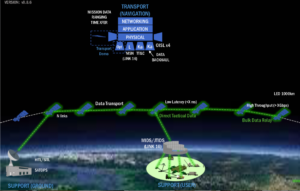
Link 16. Viasat image.
WASHINGTON: The venerable Link 16 tactical data network, used by the US and NATO allies, will serve as a key channel for the Space Development Agency’s transport layer satellites being designed as the communications backbone for future all-domain operations.
Link 16 will allow the new satellites to connect with “fighter aircraft like F-16, F-22, and F-35, missile defense networks like PAC-3 and THAAD, weapons systems, and Integrated Air and Missile Defense (IAMD) networks,” says a Lockheed Martin press release today.
Lockheed is one of two companies, along with newcomer York Space Systems, winning a contract to build 10 data relay satellites each for SDA’s future space architecture. Lockheed Martin’s contract, SDA announced yesterday, is worth $187.5 million; and York’s is worth $94 million.
Both companies are building seven “Class A” sats, each with four optical crosslinks between satellites, and three “Class B” birds, each with two optical cross links and two Link 16 links to warfighters back on Earth, SDA Director Derek Tournear told reporters yesterday. (Under questioning, he explained the price-tag discrepancy as based on the technology being brought to the table by each firm and their fixed-bid prices.)

SDA Data Transport Layer
“Adding Link 16, Integrated Broadcast System (IBS), and eventually Multifunction Advanced Data Link (MADL), will further decentralize communications, so you have fewer single-points of failure,” Erik Daehler, director of Protected Communications at Lockheed Martin Space, told me in an email today.
MADL is the stealthy data link designed for and used on F-35s.
IBS carries Ultra-High Frequency, or narrowband, communications used by the Navy’s current Mobile User Objective System (MUOS) constellation.
“While SATCOM data is a primary mission, the SDA Transport Layer will also aid in tracking hypersonic weapons, providing alternative position, navigation and timing data to augment M-Code-enabled data from GPS III/GPS IIIF, and tracking and targeting,” Daehler said.
As Breaking D readers know, SDA intends to build hundreds of small satellites, primarily in Low Earth Orbit (LEO), to build a resilient set of space capabilities from data relay (thus ‘transport layer’) to advanced missile tracking to new, jam-resistant ground systems. The architecture is composed on seven “layers” — six of them comprising satellites of various types and one being the ground segment for command and control stations, as well as receivers/radios.
Tournear said the 20 satellites, known as “Tranche 0” of the transport layer, will be launched by September 2022, and provide a “minimum” capability as a “mesh network” in space. SDA has $100 million budgeted for those satellites in 2021.
According to current SDA planning documents, the transport layer could eventually include some 500 satellites to provide global coverage.
“While SATCOM data is a primary mission, the SDA Transport Layer will also help in tracking hypersonic weapons, provide alternative position, navigation and timing (PNT) data to augment M-Code-enabled data from GPS III/GPS IIIF, and tracking and targeting,” the Lockheed Martin official said. (M-Code is the highly encrypted military signal that the Space Force is counting on to provide GPS users greater protection against jamming.)
Tournear said that SDA will open up a new bidding process for future transport layer satellites. The goal, he said, is to avoid the dreaded ‘vendor lock’ by ensuring that each contractor equips its satellites with the ability to use standards being developed by the Naval Research Laboratory to ensure they are compatible with SDA’s overarching network and with each other.
Aspiring vendors will have to “show you can plug your WiFi into our WiFi and get a signal, get a comm and get packets to transfer,” he said.
In a ‘world first,’ DARPA project demonstrates AI dogfighting in real jet
“The potential for machine learning in aviation, whether military or civil, is enormous,” said Air Force Col. James Valpiani. “And these fundamental questions of how do we do it, how do we do it safely, how do we train them, are the questions that we are trying to get after.”


























